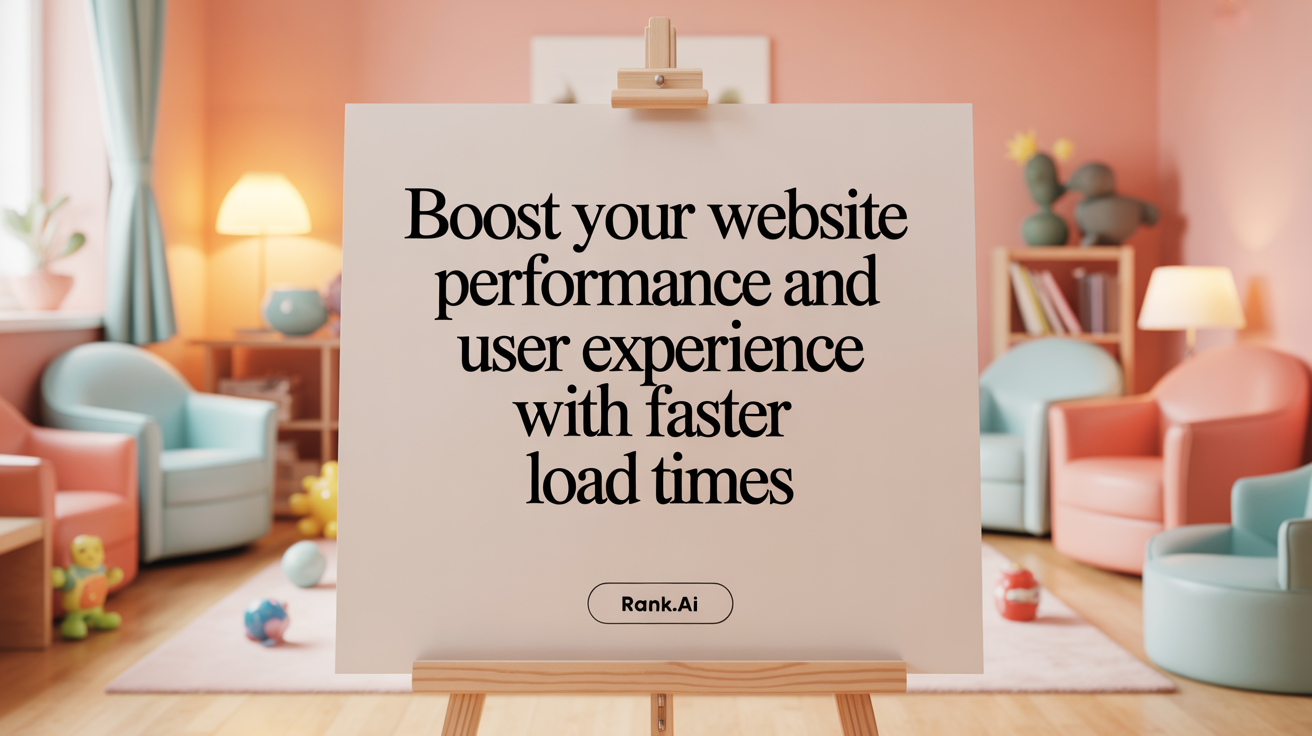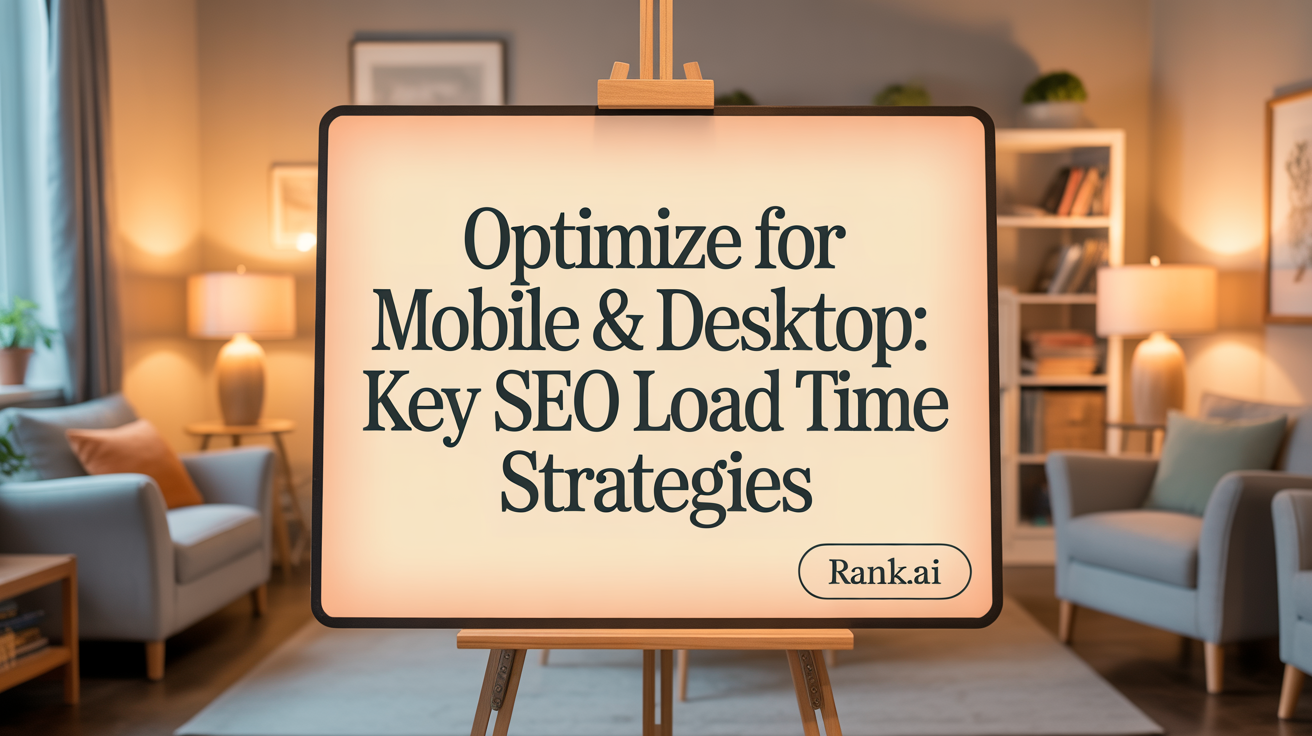The Crucial Role of Website Speed in SEO
In today's competitive digital landscape, the speed at which a website loads is more than just a convenience—it's a fundamental factor influencing search engine rankings and user experience. As businesses strive to increase visibility and engagement, understanding why fast load times have become a critical ranking factor is essential for digital success. This article explores the nuances of page load speed's impact on SEO, reveals the key metrics Google uses to evaluate site performance, and offers actionable strategies to boost website speed for better search engine results.
Why Page Load Speed Is a Critical Component of Website Optimization

Impact of load speed on user experience
Website visitors expect pages to load quickly. Studies show that around 40% of shoppers abandon sites if they take longer than three seconds to load. Fast load times not only improve the overall user experience but also reduce bounce rates. When pages load swiftly, users are more likely to stay longer, explore more content, and complete desired actions such as making purchases or filling out contact forms.
SEO implications of fast and slow websites
Google has long considered page speed a ranking factor, starting as early as April 2010. Since then, its importance has been reinforced, especially with the 2018 mobile speed update and the 2021 emphasis on Core Web Vitals—metrics like Largest Contentful Paint (LCP), First Input Delay (FID), and Cumulative Layout Shift (CLS). Faster websites tend to rank higher in search results because Google favors providing its users with a better experience. Conversely, slow-loading pages are penalized, especially if they take longer than seven seconds to initially load.
Relationship between speed, conversion rates, and brand reputation
Speed has a direct impact on conversions. For example, ecommerce sites with pages loading in less than a second see significantly higher sales—up to three times more—compared to slower sites. Every one-second delay can lead to a 7% drop in conversions. Additionally, slow sites damage reputation; 46% of users say they will never return to a poorly performing website. High-performing, fast websites also foster trust, increasing the likelihood of repeat visits and positive brand perception.
Technical aspects influencing page load speed
Several technical factors influence how quickly a website loads. These include image sizes and their compression, server response times, and the efficiency of code—HTML, CSS, and JavaScript. Using Content Delivery Networks (CDNs), leveraging browser caching, minifying code, and optimizing images are common strategies to improve speed. Mobile optimization techniques like responsive design and Accelerated Mobile Pages (AMP) further enhance loading performance, crucial given that mobile traffic now dominates overall web usage.
| Speed Metrics | Description | Why They Matter |
|---|---|---|
| TTFB | Time to First Byte | Shows server response speed |
| FCP | First Contentful Paint | Measures how quickly content appears |
| LCP | Largest Contentful Paint | Main content load timing |
| CLS | Cumulative Layout Shift | Visual stability during load |
Optimizing these aspects helps websites load faster, stay stable, and rank higher in search results, while delivering a satisfying user experience.
The Direct Impact of Page Load Speed on SEO Rankings and Performance
 Google has long considered page speed a crucial factor in SEO rankings, dating back to April 2010 when it became a ranking signal for desktop search. In July 2018, this emphasis extended to mobile search as well, recognizing the importance of fast-loading sites for mobile users. Google's April 2023 update clarified that page speed remains an element within the broader page experience signals, though its weight varies depending on the context and other ranking factors.
Google has long considered page speed a crucial factor in SEO rankings, dating back to April 2010 when it became a ranking signal for desktop search. In July 2018, this emphasis extended to mobile search as well, recognizing the importance of fast-loading sites for mobile users. Google's April 2023 update clarified that page speed remains an element within the broader page experience signals, though its weight varies depending on the context and other ranking factors.
Google's main focus in ranking pages is relevance; fast speeds can boost visibility, but high-quality, relevant content often outranks even faster sites. Nevertheless, websites that load more quickly tend to provide a much better user experience, lowering bounce rates and encouraging longer visits. These improvements can lead to higher rankings, especially when the content is comparable to competitors.
To evaluate speed, Google measures performance using metrics such as First Contentful Paint (FCP), Largest Contentful Paint (LCP), and Cumulative Layout Shift (CLS). These Core Web Vitals—available via the Chrome User Experience Report—assess how fast important content appears and how stable the page layout remains during loading. If this data is insufficient, page speed may not influence rankings.
Improving site speed involves practical strategies like optimizing images, leveraging Content Delivery Networks (CDNs), minifying code, enabling browser caching, and employing lazy loading. Mobile optimization methods such as responsive design and Accelerated Mobile Pages (AMP) are especially critical given the high mobile traffic and longer load times on mobile devices.
Research shows that faster websites directly enhance user satisfaction, reducing bounce rates. For instance, pages loading under three seconds significantly lower bounce and abandonment rates. Conversely, slow-loading sites—taking more than seven seconds—can face penalties and lower rankings. Google emphasizes that load times should ideally be under three seconds on desktop and five seconds on mobile for optimal user experience.
Tools like Google PageSpeed Insights, GTmetrix, and WebPageTest allow website owners to trace issues impacting load time, providing actionable insights. Technical improvements—such as reducing file sizes, choosing quality hosting, and optimizing server response times—are effective ways to boost speed.
While page speed is an important ranking factor, it works alongside relevance and content quality. Google’s updates, including the 2021 integration of Core Web Vitals, reflect a comprehensive approach to user experience signals influencing rankings. Faster sites not only help improve rankings but also contribute to better engagement, conversions, and overall website success.
| Metric | Description | Impact on SEO |
|---|---|---|
| FCP | First Contentful Paint | Indicates speed of first content load |
| LCP | Largest Contentful Paint | Measures when main content appears |
| CLS | Cumulative Layout Shift | Evaluates visual stability |
| TTFB | Time to First Byte | Checks server responsiveness |
| Overall Speed Measure | Includes load time for assets | Affects user experience and rankings |
Optimizing for speed is an ongoing process that combines technical improvements with content quality. When executed well, it results in a faster, more engaging website that stands a better chance of ranking high on Google and satisfying users.
Understanding Google's Key Metrics: Core Web Vitals and Beyond

What key metrics of page load time affect search ranking factors?
Google emphasizes three principal metrics known as Core Web Vitals that measure different aspects of page load performance and user experience. These are Largest Contentful Paint (LCP), Cumulative Layout Shift (CLS), and Interaction to Next Paint (INP).
LCP assesses how long it takes for the main content of a page to load and become visible to users. For optimal ranking impact, LCP should be under 2.5 seconds. CLS evaluates the visual stability of a webpage by tracking unexpected layout shifts during loading; scores of 0.1 or lower are considered good. INP (Interaction to Next Paint), a newer metric, measures the responsiveness of a page, specifically the latency between user interaction and the page responding, with a preferred target of less than 200 milliseconds.
These metrics are derived from real-world user data and are integral to Google's evaluation of website performance. Faster, stable, and responsive sites provide a better user experience, which Google recognizes as a positive ranking signal. Improving these can lead to higher visibility in search results, reduced bounce rates, and increased user engagement.
Mobile vs. Desktop Load Times: What SEO Implications You Must Know

How do differences in mobile and desktop page load times affect SEO?
Differences in mobile and desktop page load times play a significant role in SEO because of Google's shift to mobile-first indexing. This means Google primarily uses the mobile version of a website for ranking and indexing rather than the desktop version.
Mobile load times are often longer due to slower network connections, smaller screens, and different device capabilities. If a mobile page loads slowly, it can lead to higher bounce rates and lower rankings because Google emphasizes delivering a good user experience across devices.
Core Web Vitals, which include Largest Contentful Paint (LCP), First Input Delay (FID), and Cumulative Layout Shift (CLS), are all influenced by page speed. These metrics are vital ranking signals, especially on mobile devices where speed impacts usability.
Improving page speed on both device types involves strategies like optimizing images, minifying code, leveraging Content Delivery Networks (CDNs), and reducing unnecessary redirects. Prioritizing mobile load times ensures better visibility in mobile search results and enhances overall user engagement.
Ultimately, fast mobile load times not only boost your chances of ranking higher but also improve user satisfaction and retention, making speed optimization across devices essential for a successful SEO strategy.
Practical and Proven Strategies to Enhance Website Speed for SEO

What are effective strategies to improve website speed for better SEO results?
Improving website speed is crucial for better search engine rankings and enhanced user experience. There are several practical strategies that website owners can adopt to achieve faster load times.
First, optimize images by compressing them without losing quality and using appropriate formats such as WebP. Large, uncompressed images are a common cause of slow websites.
Utilizing Content Delivery Networks (CDNs) helps distribute website content across multiple servers worldwide. This means users load data from the server closest to their location, significantly reducing load times.
Minification involves removing unnecessary characters, spaces, and comments from code files like HTML, CSS, and JavaScript. This reduces file sizes and helps pages load faster. Caching strategies also play a vital role, especially browser caching, which stores static resources locally on the user's device for quicker access on subsequent visits.
Various tools are available to measure and optimize site performance. Google’s PageSpeed Insights provides actionable insights and recommendations, while GTmetrix offers detailed analysis including real browser testing and customizable test locations. These tools help identify specific bottlenecks, such as server response times or render-blocking resources.
For mobile-specific optimization, implementing responsive design ensures pages load efficiently across all device types. Techniques like AMP (Accelerated Mobile Pages) further enhance mobile speed by delivering simplified content that loads almost instantly.
Because different testing tools and settings can produce varying results, it’s advantageous to use multiple resources to gain a comprehensive view of your website’s performance. Regular audits and continuous improvements based on these insights help sustain fast load speeds.
In summary, combining image optimization, CDN deployment, code minification, caching, and continuous performance monitoring forms a robust approach to boosting website speed. These efforts not only improve SEO rankings by aligning with Google’s emphasis on fast-loading pages but also contribute to higher user satisfaction and increased conversions.
Beyond Rankings: How Fast Load Times Drive User Engagement and Business Growth
What is the relationship between website speed and conversion rates?
A faster website directly influences conversion rates, as users prefer quick-loading pages. Studies show that sites loading in less than a second can up to 2.5 times more conversions than slower sites. For example, e-commerce pages that load swiftly tend to see significant boosts in sales, making speed a crucial factor for online success.
How do load times affect bounce rates?
Bounce rates increase as load times lengthen. Visitors are likely to abandon a site if it takes more than three seconds to load. Research indicates that the bounce rate jumps from 8% on fast sites to 24% or higher on slower ones. Therefore, optimizing load speed keeps visitors engaged and reduces the chances they leave without interacting.
What are the long-term benefits of speed optimization?
Speed improvements lead to sustained benefits like higher search rankings, better user retention, and improved reputation. Over time, faster sites see increased traffic, more repeat visitors, and higher trust from users. Additionally, reducing page load times can decrease customer frustration and enhance overall user satisfaction.
Are there real-world examples of speed upgrades impacting revenue?
Yes, multiple case studies demonstrate this. Shopzilla, after reducing page load time by 3 seconds, experienced a 25% increase in page views and a 7-12% revenue increase. Amazon and Mozilla also reported significant gains in conversions following similar optimizations. These examples highlight how even small speed gains can make a business more profitable.
| Aspect | Impact of Faster Load Times | Supporting Data |
|---|---|---|
| Conversion Rates | Up to 2.5x higher | Faster sites convert more visitors into customers |
| Bounce Rate | Significantly reduced | Load time over 3 seconds increases bounce rate by nearly 3x |
| Revenue Growth | Up to 12% increase | Speed optimizations boost user engagement and sales |
Optimizing website speed is a smart investment, not just for better rankings but also for enhanced user experience and increased revenue.
Embracing Speed as a Foundation for SEO Excellence
Fast page load time is undeniably a key pillar in effective SEO strategy and user experience enhancement. As search engines continue to refine algorithms emphasizing page experience metrics, prioritizing speed is no longer optional. From the critical Core Web Vitals that Google uses to evaluate site performance to tangible impacts on bounce rates, user engagement, and conversions, a swift website sets the stage for improved rankings and sustained business success. By applying proven optimization strategies and continuously monitoring performance, website owners can deliver superior experiences that satisfy both users and search engines alike, ensuring their digital presence remains competitive and compelling.
References
- Page Speed As A Google Ranking Factor: What You Need To Know
- Doed page speed affect ranking? - Google Search Central Community
- How Fast Load Times Improve User Experience - Addicta
- Why Does Site Speed Matter and How Can I Improve It?
- Page Speed as a Google Ranking Factor and its Impact on SEO
- seo - Does Google value DOMContentLoaded or Load Time more ...
- Mobile Speed is necessary for the ranking or Desktop? - Google Help
- 6 Website Load Time Statistics and Why They Matter (2024) - Shopify
- Are You Ignoring These Critical Ranking Factors in SEO ... - Altois
- Why Site Speed Matters for SEO - Lumar



